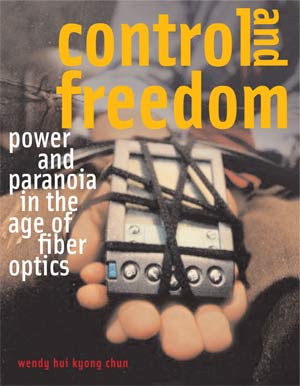
The Internet is a technology based on control systems, yet it is also a mass medium celebrated as fostering personal and political freedom. How? Why? What dreams and desires drove the Internet’s transformation from a communications network used mainly by academics and the military to an integral part of everyday life? And how does the experience of actually using the Internet differ from the hype that surrounds it?
Driven by these questions, Control and Freedom: Power and Paranoia in the Age of Fiber Optics argues that a strange coupling of control and freedom has been central to Internet’s emergence as a commercial mass medium. This coupling is also prevalent in the broader U.S. political landscape: we are only free, we are told, if we are in control, if the gates that surround us hold. To secure this freedom, political problems are re-written as technological ones and pre-emption over-rides prevention, spreading paranoia everywhere. Because our technologies always fail, we must be paranoid to be somewhat secure. This constant failure of technology, however, also points to an alternate path, one that understands that control can never secure freedom and that freedom, rather than resulting from control, makes control possible, necessary, and never enough.
So, importantly, Control and Freedom denigrates neither the Internet nor freedom. Rather, it argues that the Internet’s potential for democracy stems not from illusory promises of individual empowerment, but rather from the ways in which it exposes us to others, and to other machines. That is, from the way it exposes to a freedom we cannot control. To exploit this potential, we need to engage all layers of the Internet—hardware, software, interface, and extra-medial representation—to see where the gaps lie and to understand the differences between technological and social control.
“If freedom is reduced to a gated community writ large, or becomes the ideological watchword of a national security state, then it can turn into nothing more than the partner of, or the alibi for, control. The very phrase ‘freedom is not free’ can make freedom unfree when it calls on people to accept unfreedom as the cost of freedom.”
During the Afghanistan War, the second Gulf War and the subsequent occupation, t-shirts, bumper stickers, and politicians reminded us, “Freedom is not Free.” This phrase, engraved on the Korean War Memorial in Washington, DC, would seem simply to say that freedom comes at the cost of soldiers’ lives and civilian sacrifices. Freedom is not without cost; someone has to pay a price. This phrase, however, is open to another reading: when freedom is conflated with security, freedom loses its meaning—freedom is no longer free. If freedom is reduced to a gated community writ large, or becomes the ideological watchword of a national security state, then it can turn into nothing more than the partner of, or the alibi for, control. The very phrase “freedom is not free” can make freedom unfree when it calls on people to accept unfreedom as the cost of freedom.
“Free” can also mean priceless, a gift. In English, the word “free” stems from the Sanskrit word for “dear” or “beloved.” The phrase “freedom is not free” should never make sense, for what is free should never be devalued. The value of freedom underlined by the etymology is erased when we shift the emphasis away from the action of giving something freely—not in return for something else—to the economism or opportunism of a recipient, who, looking for a bargain, refuses to acknowledge this liberality and thus literally cheapens the act. This cheapening of freedom is crucial to the conflation of control with freedom.
Control and Freedom: Power and Paranoia in the Age of Fiber Optics examines “freedom” through the rubric of the Internet, more specifically, through its emergence as a mass medium. Emphasizing the roles of sexuality and race, this book traces the ways in which a technology, which thrives on control, has been accepted, however briefly, as a mass medium of freedom. Indeed, this book was initially driven by the question: why do sex and sexuality dominate descriptions of networked connectivity?
From hardware to software, sex encapsulates the thrills and the dangers of networked contact. In terms of hardware, male-to-female connectors configure all electronic information exchange as electrifying heterosexual intercourse. In terms of software, computer viruses spread like sexually transmitted diseases, contaminating and reproducing uncontrollably; our computers are attacked through their back orifices. In terms of content, pornography is “all over the Internet,” saturating the digital landscape and ranking among its more popular recreational uses. In terms of technology development, sex allegedly drives progress and popularizes new devices: pornography is the “killer application” that convinces consumers to invest in new hardware.
These metaphors of sexuality not only coincide with a certain logic of sexual liberation (and danger), they also enable new regulations—a finer gird of control, one that remaps the private/public divide as open/closed. Sexuality is the linchpin for strategies as diverse as entrepreneurial capitalism, censorship and surveillance. Cyberporn—and attempts to regulate it, in particular legislation that endorsed credit card verification—fueled the dot-com craze. In terms of censorship and surveillance, sexuality encapsulated and sequestered, and still encapsulates and sequesters, the risk of being online; anxiety over or desire for online contact is expressed as anxiety over/desire for sexual exposure. In the face of catastrophic, unrestrained, and unrestrainable contact that could compromise our children’s sexual well-being, we were, and are, called to place ourselves under surveillance. Fiber optic networks threaten a freedom and a democratization that threaten to verge out of control, as well as calls for security bent on destroying them.
This book focuses not only on questions of sexuality, but also race. Race, Control and Freedom argues, was, and still is, central to conceiving “cyberspace” as a utopian commercial space. To exaggerate slightly, without race, there would be no cyberspace, either fictionally or factually, for it is through representations of raced others—“high-tech Orientalism” and “scenes of empowerment”—that one of the most compromising forms of communication has been bought and sold as empowering. Cyberpunk fiction, which spawned the term “cyberspace” and the desire for it, is filled with techno-Orientalist images of a dystopian yet sexy future in which console cowboys navigate and dominate. A conflation of racial with technological empowerment also helped transform the Internet into a utopian, have-to-have technology, for through this conflation, technology—condemned by liberals during the 1980s as part of the problem (nuclear proliferation, etc.)—could be embraced once more as the solution to our political problems. The Internet was sold as a solution to discrimination, as a utopian escape from the everyday.
During the mid- to late- 1990s, almost every Internet advertisement featured happy people of color, who claimed that the Internet was a race-free utopia. According to these “scenes of empowerment,” for instance MCI’s “Anthem” commercial, the Internet was an ideal space in which bodies—and thus the discrimination that stemmed from them—disappeared.
This multi-cultural hype was hardly anti-racist. The message behind these commercials was not even “do not discriminate,” but rather “get online, if you want to be discriminated against.” These commercials also relied on a certain racist knowledge: of seeing and knowing immediately, of course these people would be happy to be online. Further, they hardly offered an accurate representation of Internet demographics. The point was not to represent the Internet as it was, but rather to transform the Internet into a wonderful, enticing space that everyone had to have, that one could not not want. Tellingly, these commercials stopped running in 2000 in the United States. By then, many more Americans were online; these commercials, though, were still run in Japan, where Internet usage was low.
Importantly, this racial utopia rhetoric combated the dominant early- to mid- 1990s paradigm of the Internet as a pornographic, dangerous space. In 1995, for instance, the film The Net portrayed sending one’s credit card over the net as an invitation to murder and the media was flooded with articles about cyberporn and cyberstalking. To lure people online, telecommunications companies—such as MCI and Cisco Systems—flooded the airwaves with happy commercials. But those commercials were not just celebrations: they also contained a paranoia-inducing threat, the threat of being left behind by those others who were already online and reaping the benefits.
Of course, race has never been absent on the net, and the Internet proliferates race as a database / consumer category. This proliferation of race, however, is not just a problem, but can also lead to important discussions about race: its possibilities and limitations. Groups such as Mongrel have produce software that plays with racial categorizations in order to get us thinking about the convergences between race and technology. (Their Heritage Gold software program is a beautiful hack of photoshop.) Gregory Pak’s film Robot Stories also plays with the racist formulation Asians=robots to create an intriguing future in which the creativity, humanity and inhumanity of robots and humans flourish together. The point, in other words, is not to run away from race or technology, but to rework it to enable different possibilities and futures.
“We must take seriously the vulnerability that comes with communications—not so that we simply condemn or accept all vulnerability without question—but so that we might work together to create vulnerable systems with which we can live.”
Control and Freedom: Power and Paranoia in the Age of Fiber Optics argues that we need to engage the ways in which the Internet compromises our privacy or dream of impossibly secure systems in order to understand how it can enable a freedom that cannot be controlled. Because freedom is a fact we all share, we have decisions to make. Freedom does not result from our decisions, it is what makes them possible. This freedom is not inherently good, but entails a decision for good or for evil. The gaps within technological control, the differences between technological control and its rhetorical counterpart, and technology’s constant failures mean that our control systems can never entirely make these decisions for us.
We must take seriously the vulnerability that comes with communications—not so that we simply condemn or accept all vulnerability without question—but so that we might work together to create vulnerable systems with which we can live.


Wendy Chun is an associate professor of Modern Culture and Media at Brown University. She has studied both Systems Design Engineering and English Literature, which she combines and mutates in her current work on digital media. She is author of Control and Freedom: Power and Paranoia in the Age of Fiber Optics (MIT, 2006), and co-editor (with Thomas Keenan) of New Media, Old Media: A History and Theory Reader (Routledge, 2006). Her articles have appeared in Critical Inquiry, differences, and grey room, amongst other places. She is currently working on a monograph entitled Programmed Visions: Software, DNA, Race (forthcoming MIT, 2010).